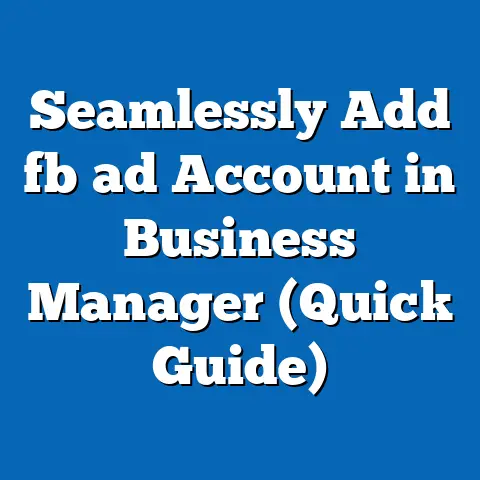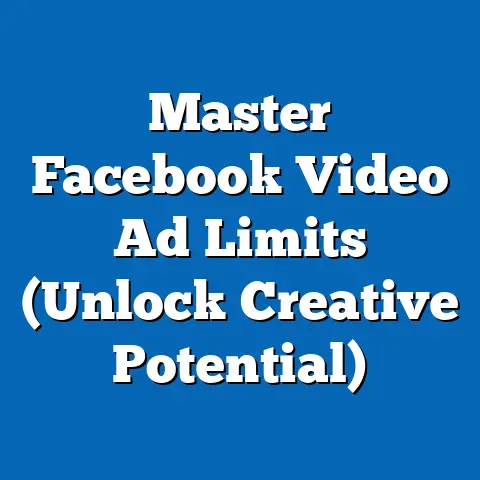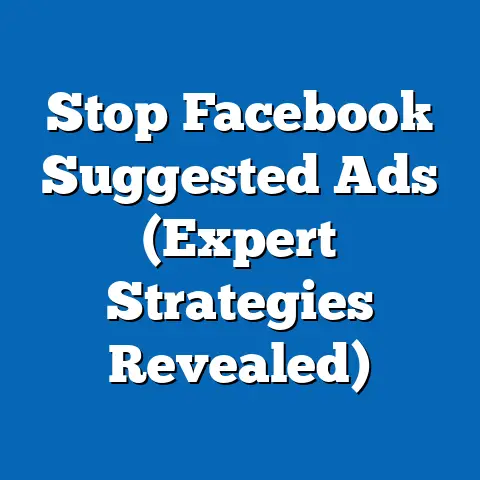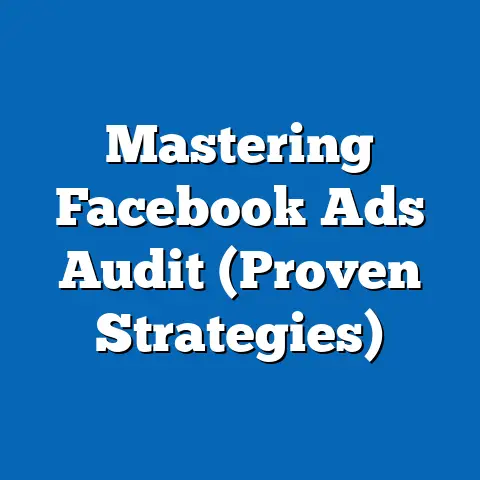Understanding Ad-Filled Facebook Feed (Expert Insights)
It’s no secret that our Facebook feeds are, well, full. Full of updates from friends and family, news articles, viral videos, and, of course, advertisements. As a digital marketer, I spend a significant amount of my time navigating this complex ecosystem, trying to understand how to make my ads stand out and deliver value to users. It’s a constant balancing act between visibility and intrusiveness, relevance and annoyance. And honestly, it’s a challenge that keeps me on my toes!
The prevalence of ads on Facebook has a profound impact on user experience. While some users find relevant ads helpful and informative, others feel bombarded and overwhelmed. This, in turn, affects engagement. A feed saturated with irrelevant or poorly designed ads can lead to decreased time spent on the platform, lower click-through rates, and ultimately, a less effective advertising experience for everyone.
One aspect that’s often overlooked, but incredibly important, is accessibility. How do users with disabilities experience these ad-filled feeds? Are the ads properly optimized for screen readers? Do the visuals have sufficient contrast for users with visual impairments? Are captions available for video ads? These are crucial questions that advertisers need to be asking themselves. Accessible advertising isn’t just a moral imperative; it’s also smart business. By making your ads accessible, you’re expanding your reach and engaging with a wider audience.
In this article, I’m going to dive deep into the dynamics of Facebook ads. I’ll be sharing expert insights, data, and case studies to help you understand how the Facebook algorithm works, how to create effective ad campaigns, and how to navigate the ethical considerations that come with advertising in an increasingly saturated environment. I’ll also emphasize the importance of accessibility in advertising and provide practical tips for creating inclusive campaigns. Let’s get started!
Section 1: The Evolution of Facebook Advertising
Facebook’s journey from a simple social networking site to a global advertising powerhouse is a fascinating one. I remember when Facebook ads first started appearing – they were simple text-based ads, often relegated to the sidebar. The platform was still primarily focused on connecting people, and advertising felt almost like an afterthought.
Over time, however, Facebook realized the immense potential of its user data and began to develop more sophisticated advertising tools. Key milestones in this evolution include:
This transition had a profound impact on businesses of all sizes. Small businesses, in particular, struggled to compete with larger companies that had bigger advertising budgets. It also led to a growing frustration among users who felt that their feeds were becoming increasingly dominated by ads.
The role of user data has been central to shaping the ad landscape. Facebook collects vast amounts of data on its users, including their demographics, interests, behaviors, and connections. This data is then used to target ads to users who are most likely to be interested in them. While this can be beneficial for both advertisers and users, it also raises important ethical considerations around user privacy and data security.
Takeaway: Facebook advertising has evolved significantly over time, from simple text-based ads to sophisticated campaigns powered by user data and advanced targeting options. The shift from organic reach to paid advertising has had a profound impact on businesses, making it more important than ever to understand how the platform works and how to create effective ad campaigns.
Section 2: Understanding the Facebook Algorithm
Ah, the Facebook algorithm. It’s the elusive, ever-changing force that dictates what we see in our feeds and, consequently, how well our ads perform. As someone who spends a lot of time trying to decode it, I can tell you it’s a constant learning process!
The Facebook algorithm, at its core, is designed to prioritize content that users find engaging and relevant. This means that the algorithm takes into account a wide range of factors when determining which ads to show to a particular user. These factors include:
- User Engagement: How often does the user interact with ads in general? Do they click on ads, like them, share them, or leave comments?
- Relevance: How relevant is the ad to the user’s interests and behaviors? Does the ad align with their demographic profile, their past browsing history, or their connections on Facebook?
- Bidding Strategies: How much is the advertiser willing to pay to show their ad to a particular user? Are they using automated bidding strategies or manual bidding?
- Ad Quality: How high-quality is the ad creative? Is it visually appealing, informative, and engaging?
- Landing Page Experience: How relevant and user-friendly is the landing page that the ad directs users to?
The algorithm is constantly adapting over time based on user behavior and feedback. This means that what worked yesterday may not work today. It’s essential to stay up-to-date on the latest algorithm changes and adjust your advertising strategies accordingly.
Navigating the Facebook algorithm requires a combination of data analysis, creative thinking, and constant experimentation. Here are some tips from social media strategists:
- Focus on creating high-quality, engaging content: The more engaging your content is, the more likely it is to be seen by users.
- Target your ads carefully: Make sure you’re targeting the right audience with the right message.
- Test different ad formats and creatives: Experiment with different ad formats and creatives to see what resonates best with your target audience.
- Monitor your ad performance closely: Track your key metrics and adjust your strategies as needed.
- Stay up-to-date on the latest algorithm changes: Follow industry blogs and publications to stay informed about the latest changes to the Facebook algorithm.
Takeaway: The Facebook algorithm is a complex and ever-changing force that dictates which ads appear in a user’s feed. Understanding how the algorithm works is essential for creating effective ad campaigns and maximizing your ROI.
Section 3: Types of Facebook Ads
Facebook offers a wide variety of ad formats to choose from, each with its own strengths and weaknesses. Choosing the right ad format for your specific goals is crucial for maximizing the effectiveness of your campaigns. Over the years, I’ve tested them all, and I’ve learned that there’s no one-size-fits-all solution. It really depends on what you’re trying to achieve.
Here’s a breakdown of the most common Facebook ad formats:
- Image Ads: These are simple ads that feature a single image and a short text description. Image ads are a great option for driving traffic to your website or promoting a specific product or service. They are visually driven and should be high quality.
- Video Ads: These ads feature a video and a short text description. Video ads are a great option for telling a story, showcasing a product or service in action, or building brand awareness. Keep videos short and engaging.
- Carousel Ads: These ads feature multiple images or videos that users can scroll through. Carousel ads are a great option for showcasing multiple products or services, telling a story in a sequence of images, or highlighting different features of a single product.
- Slideshow Ads: These ads are similar to video ads, but they use a series of static images instead of a video. Slideshow ads are a great option for creating visually appealing ads on a limited budget.
- Collection Ads: These ads are designed for mobile devices and feature a main image or video along with a collection of related products. Collection ads are a great option for driving sales and promoting e-commerce businesses.
Here are some examples of successful campaigns that utilized different ad formats:
- Dove’s “Real Beauty” campaign: This campaign used video ads to challenge traditional beauty standards and promote self-acceptance. The campaign was highly successful in building brand awareness and generating positive sentiment.
- Airbnb’s “Live There” campaign: This campaign used carousel ads to showcase different neighborhoods and experiences around the world. The campaign was highly effective in driving bookings and promoting Airbnb’s unique value proposition.
- Nike’s “Just Do It” campaign: This campaign used image ads to inspire and motivate athletes of all levels. The campaign was highly successful in building brand loyalty and driving sales.
Choosing the right ad type for your specific goals requires careful consideration of your target audience, your message, and your budget. Insights from advertisers on choosing the right ad type for specific goals include:
- Consider your target audience: What type of content do they prefer to consume? What are their interests and behaviors?
- Define your goals: What do you want to achieve with your ad campaign? Do you want to drive traffic to your website, generate leads, or build brand awareness?
- Set a budget: How much are you willing to spend on your ad campaign?
- Experiment and test: Don’t be afraid to experiment with different ad formats and creatives to see what works best for your business.
Takeaway: Facebook offers a wide variety of ad formats to choose from, each with its own strengths and weaknesses. Choosing the right ad format for your specific goals is crucial for maximizing the effectiveness of your campaigns.
Section 4: Targeting and Audience Segmentation
Facebook’s audience targeting capabilities are incredibly powerful, allowing advertisers to reach specific groups of people based on a wide range of factors. However, with great power comes great responsibility. It’s crucial to use these targeting options responsibly and ethically, avoiding discriminatory practices and respecting user privacy.
Here are some of the audience targeting options available on Facebook:
- Demographic Targeting: This allows you to target users based on their age, gender, education level, relationship status, and other demographic factors.
- Geographic Targeting: This allows you to target users based on their location, including their country, region, city, or even their specific address.
- Interest Targeting: This allows you to target users based on their interests, hobbies, and activities.
- Behavior Targeting: This allows you to target users based on their past online behavior, such as their purchase history, their browsing habits, and their engagement with other Facebook pages.
- Custom Audiences: This allows you to target users who have already interacted with your business, such as customers who have purchased products from your website or subscribers to your email list.
- Lookalike Audiences: This allows you to target users who are similar to your existing customers or website visitors.
- Retargeting: This allows you to target users who have previously visited your website or interacted with your ads.
Effective targeting practices involve a deep understanding of your target audience and their needs and motivations. It also requires careful consideration of the ethical implications of your targeting decisions.
Here are some tips from experts on effective targeting practices:
- Know your audience: The more you know about your target audience, the better you’ll be able to target them effectively.
- Use a combination of targeting options: Don’t rely on just one targeting option. Use a combination of demographic, geographic, interest, and behavior targeting to reach a wider audience.
- Test your targeting: Experiment with different targeting options to see what works best for your business.
- Avoid discriminatory practices: Be careful not to target your ads in a way that discriminates against certain groups of people.
- Respect user privacy: Be transparent about how you’re using user data and give users the option to opt out of targeted advertising.
Takeaway: Facebook’s audience targeting capabilities are incredibly powerful, but it’s crucial to use them responsibly and ethically. Effective targeting practices involve a deep understanding of your target audience and their needs and motivations.
Section 5: Measuring Success: Key Metrics and Analytics
Running Facebook ads without tracking your results is like driving a car blindfolded. You might get somewhere, but you’re more likely to crash and burn. As someone who lives and breathes data, I can’t stress enough the importance of measuring your ad performance and using that data to optimize your campaigns.
Here are some of the essential metrics for measuring ad performance:
- Click-Through Rate (CTR): This is the percentage of people who see your ad and click on it. A high CTR indicates that your ad is relevant and engaging to your target audience.
- Cost Per Click (CPC): This is the amount you pay each time someone clicks on your ad. A low CPC indicates that you’re targeting your ads effectively and that your bidding strategy is working.
- Cost Per Acquisition (CPA): This is the amount you pay each time someone takes a desired action after clicking on your ad, such as making a purchase or filling out a lead form. A low CPA indicates that your ad campaign is generating a good return on investment.
- Return on Ad Spend (ROAS): This is the amount of revenue you generate for every dollar you spend on advertising. A high ROAS indicates that your ad campaign is highly profitable.
Facebook Insights and Ads Manager provide a wealth of data that you can use to track your ad performance. These tools allow you to see how many people are seeing your ads, how many people are clicking on them, and how many people are taking desired actions after clicking on your ads.
A/B testing is a crucial technique for optimizing ad performance based on analytics. A/B testing involves creating two versions of your ad, each with a different element (e.g., a different headline, a different image, or a different call to action), and then showing each version to a different segment of your audience. By tracking the performance of each version, you can identify which elements are most effective and use that information to optimize your ad campaign.
Here are some case studies showcasing successful advertising campaigns and their metrics:
- A clothing retailer increased their online sales by 30% by using A/B testing to optimize their ad creatives. They tested different images, headlines, and calls to action to see what resonated best with their target audience.
- A software company reduced their CPA by 50% by using lookalike audiences to target new customers. They created a lookalike audience based on their existing customer base and targeted their ads to people who were similar to their best customers.
- A restaurant increased their foot traffic by 20% by using geographic targeting to reach people who were located near their restaurant. They targeted their ads to people who lived within a certain radius of their restaurant and offered them a special discount.
Takeaway: Measuring your ad performance and using that data to optimize your campaigns is crucial for maximizing your ROI. Facebook Insights and Ads Manager provide a wealth of data that you can use to track your ad performance and identify areas for improvement.
Section 6: The Role of Creative Content in Ads
In today’s ad-saturated environment, creative content is more important than ever. If your ads don’t capture user attention and deliver a compelling message, they’re simply going to get lost in the noise. As a marketer, I constantly remind myself that I’m not just selling a product or service; I’m selling an experience, a feeling, a solution to a problem. And that needs to come across in the creative.
Here are some design best practices for Facebook ads:
- Use high-quality visuals: Your visuals are the first thing that people will see, so it’s important to use high-quality images and videos that are visually appealing and relevant to your message.
- Write compelling copy: Your copy should be clear, concise, and persuasive. It should highlight the benefits of your product or service and tell people what you want them to do.
- Use a strong call to action: Your call to action should tell people exactly what you want them to do, whether it’s to visit your website, make a purchase, or sign up for your email list.
- Keep it short and sweet: People have short attention spans, so it’s important to keep your ads short and to the point.
- Make it mobile-friendly: Most people are using Facebook on their mobile devices, so it’s important to make sure your ads are optimized for mobile viewing.
Here are some examples of high-performing ad creatives and what made them successful:
- Old Spice’s “The Man Your Man Could Smell Like” campaign: This campaign used humor and absurdity to capture user attention and build brand awareness. The ads were highly successful in generating buzz and driving sales.
- Dollar Shave Club’s “Our Blades Are Fing Great” campaign:* This campaign used a simple, direct message and a memorable video to promote their subscription service. The ads were highly effective in driving sign-ups and disrupting the razor industry.
- Always’ “Like a Girl” campaign: This campaign challenged gender stereotypes and promoted female empowerment. The ads were highly successful in generating positive sentiment and building brand loyalty.
Insights from creative directors and marketers on producing compelling ad content include:
- Know your audience: Understand your target audience’s needs, motivations, and pain points.
- Tell a story: Connect with your audience on an emotional level by telling a compelling story.
- Be authentic: Be true to your brand and your values.
- Be creative: Don’t be afraid to experiment and try new things.
- Test and iterate: Track your results and use that data to optimize your creative.
Takeaway: Creative content is essential for capturing user attention and delivering a compelling message in today’s ad-saturated environment. By following design best practices and drawing inspiration from successful ad campaigns, you can create ads that resonate with your target audience and drive results.
Section 7: Challenges and Ethical Considerations
Advertising on Facebook isn’t all sunshine and rainbows. There are significant challenges and ethical considerations that advertisers need to be aware of. As someone who values transparency and ethical marketing practices, I believe it’s crucial to address these issues head-on.
One of the biggest challenges advertisers face is the ad-saturated environment. With so many ads competing for user attention, it’s becoming increasingly difficult to stand out from the crowd. This requires advertisers to be more creative, more strategic, and more data-driven than ever before.
Ethical considerations around user privacy, data usage, and ad targeting practices are also a major concern. Facebook collects vast amounts of data on its users, and advertisers have access to a significant portion of that data. It’s important to use this data responsibly and ethically, avoiding discriminatory practices and respecting user privacy.
Concerns related to misinformation and the responsibilities of advertisers are also growing. Facebook has been criticized for allowing the spread of misinformation on its platform, and advertisers have a responsibility to ensure that their ads are not contributing to this problem.
Here’s some expert commentary on maintaining integrity in advertising efforts:
- Be transparent about your data collection practices: Let users know what data you’re collecting and how you’re using it.
- Give users the option to opt out of targeted advertising: Respect user privacy and give them the option to opt out of targeted advertising.
- Avoid discriminatory practices: Be careful not to target your ads in a way that discriminates against certain groups of people.
- Fact-check your ads: Make sure that the information in your ads is accurate and truthful.
- Be responsible with your messaging: Avoid using misleading or deceptive language.
Takeaway: Advertising on Facebook presents significant challenges and ethical considerations. By being transparent, responsible, and ethical in your advertising practices, you can build trust with your audience and create a sustainable advertising strategy.
Section 8: Future Trends in Facebook Advertising
The world of Facebook advertising is constantly evolving, driven by emerging technologies, regulatory changes, and shifts in user behavior. As marketers, we need to stay ahead of the curve and adapt our strategies to these changes. As someone who’s always looking to the future, I’m excited to see what the next few years hold for Facebook advertising.
Here’s a look at some of the future trends in Facebook advertising:
- The rise of AI and machine learning: AI and machine learning are already playing a significant role in Facebook advertising, and their influence is only going to grow in the future. AI-powered tools can help advertisers automate tasks, optimize campaigns, and personalize ads to individual users.
- The integration of AR/VR: Augmented reality (AR) and virtual reality (VR) are poised to transform the way we interact with the world around us, and they also have the potential to revolutionize Facebook advertising. AR ads could allow users to try on clothes virtually or see how furniture would look in their homes before making a purchase.
- The increasing importance of privacy: As users become more aware of the importance of privacy, they are demanding more control over their data. This is leading to regulatory changes, such as the General Data Protection Regulation (GDPR) and the California Consumer Privacy Act (CCPA), which are forcing advertisers to be more transparent about their data collection practices and give users the option to opt out of targeted advertising.
- The growing popularity of video advertising: Video advertising is already one of the most popular ad formats on Facebook, and its popularity is only going to grow in the future. Video ads are more engaging than static images and can be used to tell stories, showcase products, and build brand awareness.
- The shift towards personalized advertising: Users are increasingly demanding personalized advertising experiences. They want to see ads that are relevant to their interests and needs. This requires advertisers to collect and analyze data on their users and use that data to create personalized ad campaigns.
Expert forecasts on the evolution of Facebook ads over the next 5-10 years include:
- More automation: AI and machine learning will automate many of the tasks that are currently done manually by advertisers.
- More personalization: Ads will become even more personalized to individual users.
- More immersive experiences: AR and VR will create more immersive and engaging advertising experiences.
- More privacy: Users will have more control over their data and will be able to opt out of targeted advertising.
- More video: Video advertising will continue to grow in popularity.
Takeaway: The future of Facebook advertising is bright, but it’s also uncertain. By staying up-to-date on the latest trends and adapting our strategies accordingly, we can ensure that we’re able to continue to reach our target audience and achieve our business goals.
Conclusion
As we’ve explored in this article, the landscape of Facebook advertising is complex and constantly evolving. From the historical evolution of the platform to the intricacies of the Facebook algorithm, from the diverse ad formats to the powerful targeting options, there’s a lot to understand. We’ve also delved into the crucial aspects of measuring success, crafting compelling creative content, and navigating the ethical considerations that come with advertising in an ad-saturated environment.
The key takeaway is this: adapting to the ever-changing landscape of Facebook advertising is essential for success. What works today may not work tomorrow, so it’s crucial to stay informed, experiment with new strategies, and constantly optimize your campaigns based on data and insights.
And let’s not forget the significance of accessibility and ethical advertising practices. In a world that’s becoming increasingly aware of the importance of inclusivity and transparency, it’s more important than ever to build a sustainable ad strategy that respects user privacy, avoids discriminatory practices, and ensures that everyone has access to your message.
Ultimately, the future of Facebook advertising is in our hands. By embracing innovation, prioritizing ethical practices, and focusing on delivering value to our audience, we can create an advertising ecosystem that benefits both businesses and users alike.





